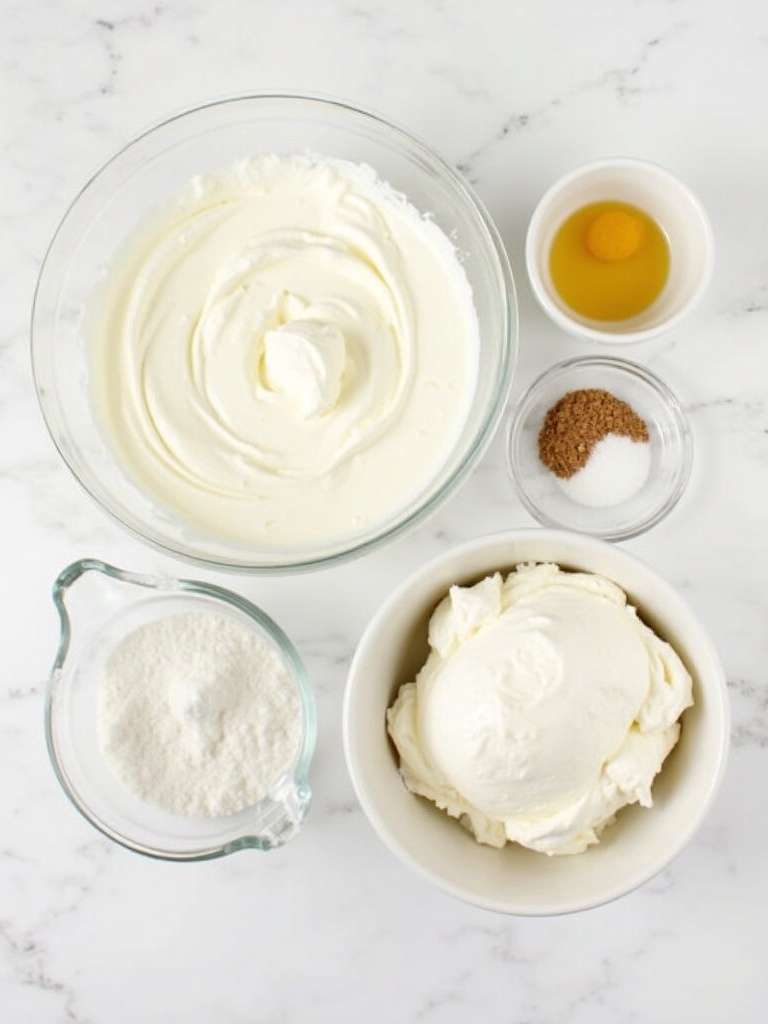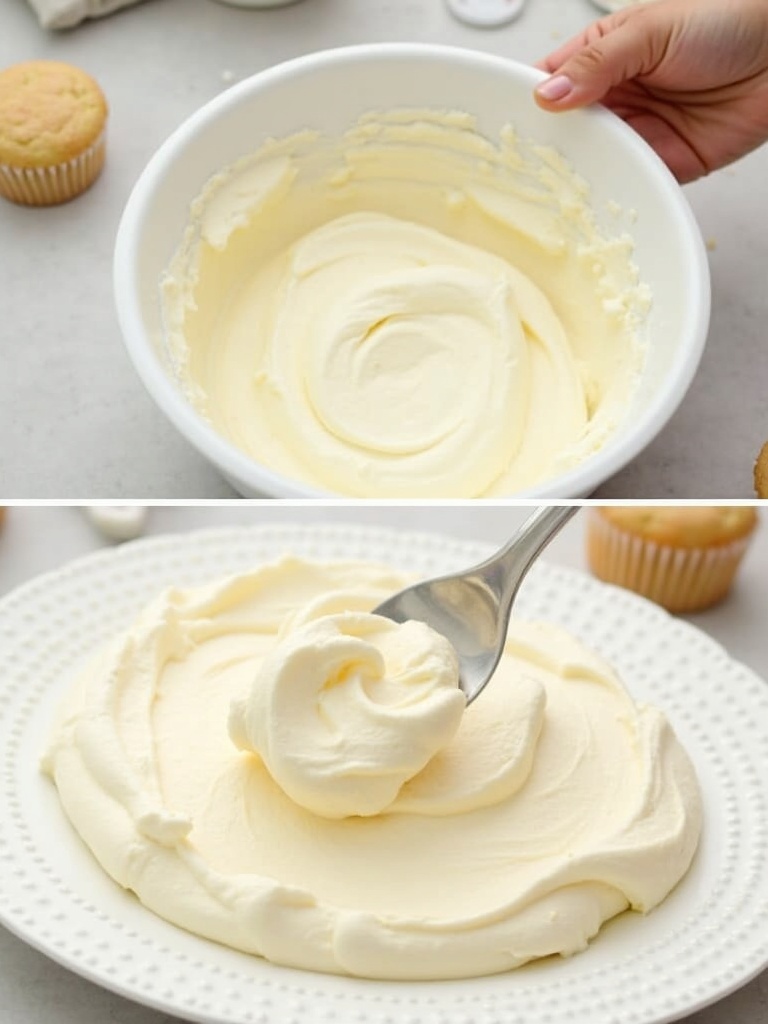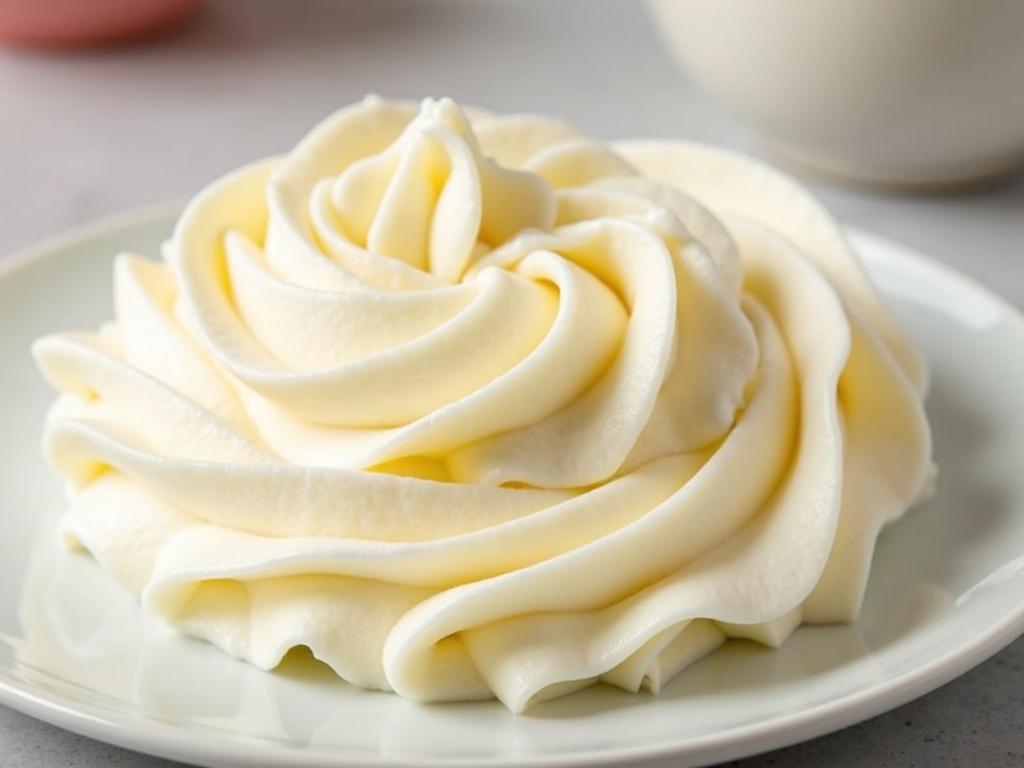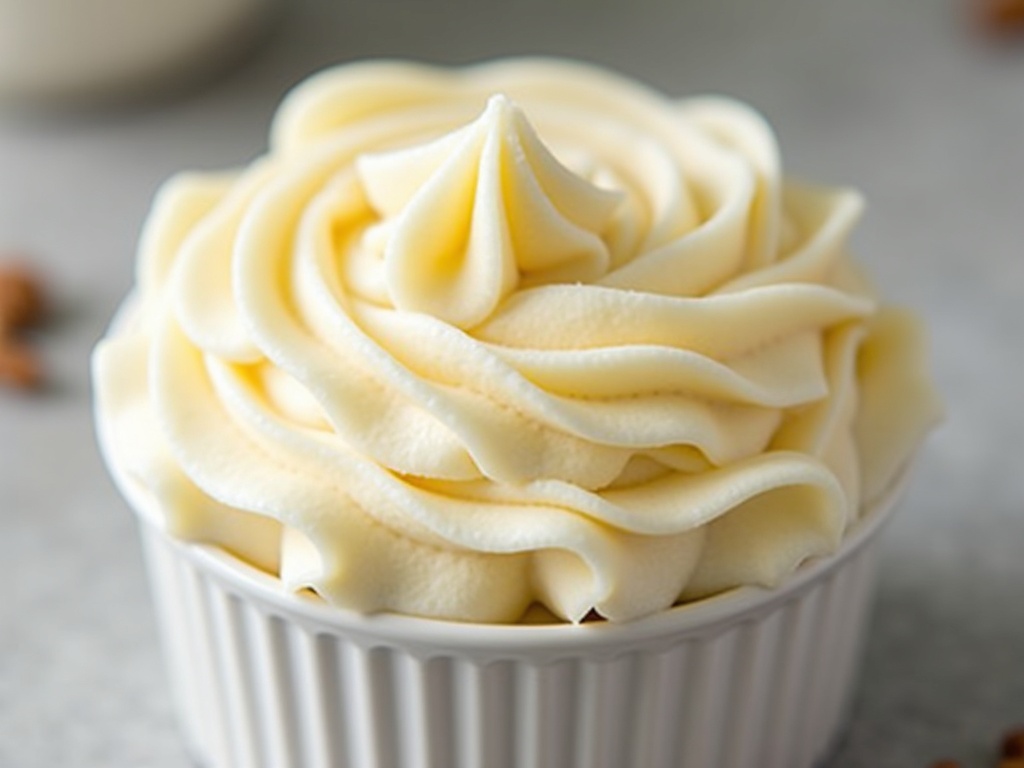Introduction
I’ve spent years perfecting my buttercream frosting recipe, testing countless variations to find the ideal balance of sweetness, stability, and spreadability. The beauty of this frosting lies in its simplicity—with just a handful of quality ingredients, you can create a versatile base that pairs beautifully with everything from rich zucchini bread to classic strawberry shortcake. What makes this buttercream frosting recipe special is its adaptability—you can easily customize it with different flavorings, colors, and textures to suit any occasion or dessert pairing.
Table of Contents
Ingredients You Will Need

The foundation of any exceptional buttercream frosting recipe starts with quality ingredients. Here’s everything you’ll need to create frosting that’s silky smooth, perfectly sweet, and ideal for decorating:
- 1 cup (226g) unsalted butter, softened to room temperature
- 4 cups (480g) powdered sugar (confectioners’ sugar), sifted
- 2-3 tablespoons heavy cream or whole milk
- 2 teaspoons pure vanilla extract
- 1/4 teaspoon fine sea salt
For the best results, each ingredient plays a crucial role in your buttercream frosting recipe. The butter provides the rich, creamy base, while sifted powdered sugar ensures smoothness without any lumps. Heavy cream adds luxurious texture, while vanilla extract and salt balance the sweetness with depth of flavor.
If you need substitutions, consider these options:
- Vegan butter can replace regular butter for a dairy-free version
- Coconut cream works beautifully instead of heavy cream
- Almond extract offers a delightful alternative to vanilla
- Plant-based milk can substitute for dairy milk in equal amounts
When selecting butter for your buttercream frosting recipe, European or high-fat varieties will produce an exceptionally rich result that pipes beautifully. The texture of your frosting will thank you for this small upgrade!
Timing
Creating the perfect buttercream frosting recipe is remarkably quick compared to other frosting types like Swiss meringue or Italian meringue buttercream. Here’s a breakdown of the time investment:
- Preparation time: 5 minutes (bringing butter to room temperature takes 30-60 minutes)
- Active mixing time: 10 minutes
- Total time: 15 minutes (excluding butter softening)
This buttercream frosting recipe requires 40% less active time than Swiss meringue buttercream, which typically takes about 25 minutes of constant attention. The time efficiency makes American buttercream particularly appealing for busy bakers or last-minute decorating needs.
I recommend allowing butter to come to room temperature naturally rather than microwaving it, as proper butter consistency forms the foundation of a successful buttercream frosting recipe. If you’re in a hurry, cut the butter into small cubes to speed up the softening process.
Step-by-Step Instructions

Step 1: Prepare the Butter
Start with room temperature butter—this is absolutely critical for a smooth buttercream frosting recipe. Place the softened butter in a large mixing bowl and beat on medium speed for 2-3 minutes until it becomes pale and fluffy. This lengthy initial beating incorporates air, creating a lighter texture in your final product.
If your kitchen is warm, avoid letting the butter become too soft or greasy. The ideal consistency is when you can easily press your finger into it but it still maintains some structure—similar to the texture of peanut butter.
Step 2: Add the Powdered Sugar
For the smoothest buttercream frosting recipe, sifting your powdered sugar is non-negotiable. Add the sifted powdered sugar to the creamed butter one cup at a time, mixing on low speed after each addition until incorporated. This gradual approach prevents the sugar cloud that can occur when you add it all at once.
Between additions, scrape down the sides of the bowl thoroughly to ensure even mixing—this is a step many bakers overlook but makes a significant difference in the final texture of your frosting.
Step 3: Mix in Liquid Ingredients
Once all the sugar is incorporated, add the vanilla extract and salt to your buttercream frosting recipe. The salt might seem surprising, but it’s the secret ingredient that balances sweetness and enhances the buttery flavor. Mix until thoroughly combined.
Now gradually add the heavy cream or milk one tablespoon at a time, beating on medium speed after each addition. The liquid helps achieve that dreamy, spreadable consistency that’s perfect for decorating snickerdoodle cookies or covering a delicious peach crisp.
Step 4: Beat Until Fluffy
This is where the magic happens in your buttercream frosting recipe. Once all ingredients are combined, increase the mixer speed to medium-high and beat for 3-5 minutes until the frosting becomes incredibly light and fluffy. This extended beating period incorporates air into the mixture, resulting in a silky texture that spreads like a dream.
If the frosting appears too thick, add more cream, one teaspoon at a time. If it’s too thin, add more powdered sugar, two tablespoons at a time, until you reach the desired consistency.
Step 5: Customize Your Frosting
One of the best aspects of this basic buttercream frosting recipe is its versatility. At this point, you can customize your frosting by adding:
- Food coloring (gel colors work best as they don’t thin the frosting)
- Flavor extracts like almond, lemon, or peppermint (start with 1/4 teaspoon)
- Cocoa powder (add 1/4 cup for a chocolate variation)
- Citrus zest (1-2 teaspoons adds bright flavor)
- Freeze-dried fruit powder for natural coloring and flavor
When adding these customizations to your buttercream frosting recipe, start with small amounts and taste as you go—it’s much easier to add more than to fix an overpowering flavor.

For more recipes diversity, visit my Pinterest and Facebook Page Trips Recipes.
Nutritional Information
Understanding the nutritional profile of your buttercream frosting recipe helps you make informed choices about portion sizes. Here’s a breakdown based on a 2-tablespoon serving:
- Calories: 180-200 calories
- Total Fat: 11g (17% DV)
- Saturated Fat: 7g (35% DV)
- Cholesterol: 30mg (10% DV)
- Sodium: 30mg (1% DV)
- Total Carbohydrates: 22g (7% DV)
- Sugars: 22g
- Protein: 0g
This buttercream frosting recipe provides approximately 16 two-tablespoon servings, making it easy to calculate how much you’ll need for various baking projects. Remember that buttercream is meant to be an occasional treat rather than a dietary staple.
Healthier Alternatives for the Recipe
While traditional buttercream frosting recipe is undeniably delicious, I understand that many bakers look for ways to create healthier versions. Here are some modifications that maintain the delightful flavor while improving the nutritional profile:
- Replace half the butter with whipped cream cheese for a tangier, less sweet frosting with fewer calories
- Use organic powdered sugar or make your own by blending raw cane sugar with cornstarch
- Incorporate Greek yogurt (strained overnight) to replace some of the butter for added protein
- Try coconut cream instead of heavy cream for plant-based fats and subtle flavor
- Use maple syrup powder or date sugar for alternative natural sweeteners
- Add a bit more salt to reduce the amount of sugar needed while maintaining flavor balance
- Incorporate puréed fruits like banana or strawberry to add natural sweetness and reduce sugar
These modifications to the classic buttercream frosting recipe can reduce the calorie content by up to 30% while still creating a delicious topping for your American pancakes or other baked goods.
Serving Suggestions
Your homemade buttercream frosting recipe deserves to be showcased in creative and delicious ways. Here are versatile serving ideas to inspire your next baking project:
- Pipe decorative swirls onto cupcakes using different tips for varied designs
- Spread between layers of cake for a classic celebration dessert
- Create a smooth finish on cookies for an elevated treat
- Fill macarons for a gourmet touch
- Sandwich between graham crackers for quick mini-desserts
- Dollop onto warm rhubarb crisp as an alternative to ice cream
- Use as a dip for fresh strawberries, pretzels, or cookies
- Pipe onto brownies for an indulgent upgrade
- Create a two-tone effect by dividing the frosting and adding different colors to the piping bag
- Fill crepes or roll into chocolate-dipped strawberries for special occasions
This buttercream frosting recipe maintains its shape beautifully at room temperature, making it perfect for events where your treats will be displayed for several hours.
Common Mistakes to Avoid
Even experienced bakers can encounter challenges with their buttercream frosting recipe. Here are the most common pitfalls and how to avoid them:
- Using cold butter: Always ensure butter is properly softened to room temperature (65-70°F) for smooth incorporation
- Over-mixing: While thorough mixing is important, excessive beating can incorporate too much air, creating a frosting that’s difficult to smooth
- Under-sifting the sugar: Skipping this step leads to lumpy frosting that’s frustrating to work with
- Adding too much liquid: Incorporate cream gradually to prevent a runny consistency that won’t hold its shape
- Starting with the wrong butter-to-sugar ratio: Maintain the proportions in this buttercream frosting recipe for reliable results
- Neglecting the salt: This crucial ingredient balances sweetness—don’t skip it!
- Using artificial vanilla: Pure vanilla extract provides significantly better flavor than imitation versions
- Coloring with liquid food coloring: Gel or powder colorings won’t thin your frosting
- Working in an overly warm kitchen: If your kitchen exceeds 75°F, the butter may become too soft during beating
According to professional decorators, temperature control is the number one factor affecting the success of any buttercream frosting recipe, accounting for approximately 70% of frosting failures.
Storing Tips for the Recipe
Proper storage extends the life of your buttercream frosting recipe and maintains its delicious flavor and texture. Follow these guidelines for best results:
- Room temperature: Buttercream can remain at room temperature (70°F or below) for up to 2 days in an airtight container
- Refrigeration: Store in an airtight container for up to 1 week; bring to room temperature and re-whip before using
- Freezing: Buttercream freezes beautifully for up to 3 months in airtight containers or freezer bags
- Thawing: Allow frozen buttercream to thaw overnight in the refrigerator, then bring to room temperature and re-whip until fluffy
- Piping bags: Store filled piping bags with tips in drinking glasses covered with damp paper towels to prevent crusting
- Covering cakes: Once frosted, cakes with this buttercream frosting recipe should be stored in cake carriers or under cake domes to prevent drying
- Tinting in advance: Colored buttercream deepens over time, so make it slightly lighter than your desired final shade if preparing in advance
Professional bakers recommend storing your buttercream frosting recipe away from strong-smelling foods, as fats readily absorb odors that can alter the delicate flavor profile.
Conclusion
Mastering this classic buttercream frosting recipe opens up a world of decorating possibilities that will transform your homemade baked goods into professional-looking treats. The beautiful balance of rich butter and sweet powdered sugar creates a versatile canvas that adapts to countless flavors, colors, and decorating techniques.
I encourage you to experiment with this foundational buttercream frosting recipe—try different flavor extracts, incorporate seasonal ingredients, or practice new piping techniques to expand your baking skills. Remember that perfection comes with practice, so don’t be discouraged if your first attempt isn’t flawless.
The joy of sharing homemade treats topped with your creamy, delicious frosting makes the effort worthwhile. Whether you’re decorating birthday cupcakes, creating an anniversary cake, or simply adding a special touch to afternoon cookies, this buttercream frosting recipe will never disappoint.
I’d love to hear how your frosting adventures turn out! Share your creations, adaptations, or questions in the comments below—your experiences help build our community of home bakers supporting each other.
FAQs
Why is my buttercream frosting grainy?
Grainy texture in your buttercream frosting recipe usually results from insufficiently sifted powdered sugar. Always sift the sugar before adding it to the butter, and beat the mixture thoroughly on medium speed for at least 3-5 minutes to dissolve any remaining sugar crystals. Using room temperature butter also helps prevent graininess.
Can I make buttercream frosting ahead of time?
Absolutely! This buttercream frosting recipe can be made up to 3 days in advance and stored in an airtight container in the refrigerator. When ready to use, allow it to come to room temperature (about 1-2 hours), then re-whip for 2-3 minutes until fluffy before using.
How do I make chocolate buttercream frosting?
To transform this basic buttercream frosting recipe into chocolate buttercream, add 1/2 cup of unsweetened cocoa powder (sifted) after incorporating the powdered sugar. You may need to add an extra tablespoon of cream to maintain the proper consistency. For a richer chocolate flavor, you can also add 4 ounces of melted and cooled semisweet chocolate.
Why is my buttercream frosting too runny?
Runny buttercream frosting recipe typically results from adding too much liquid, using butter that’s too warm, or working in a hot kitchen. To fix runny buttercream, refrigerate it for 15-20 minutes, then re-whip. If it’s still too soft, gradually add more sifted powdered sugar, 2-3 tablespoons at a time, until it reaches your desired consistency.
How much buttercream do I need for a cake?
For a standard 8-inch two-layer cake, this buttercream frosting recipe provides the perfect amount for filling, crumb coating, and final decorating. For cupcakes, you’ll get enough frosting for approximately 18-24 cupcakes, depending on how generously you frost them. If you’re creating elaborate decorations, consider making 1.5x the recipe.
Can buttercream frosting be left out overnight?
This buttercream frosting recipe can safely remain at cool room temperature (below 70°F) for up to 2 days because the high sugar content acts as a preservative. However, in warm weather or for longer storage, refrigeration is recommended. Frosted cakes and cupcakes can be left at room temperature overnight if kept in a cool place.
What’s the difference between buttercream and cream cheese frosting?
While this buttercream frosting recipe uses primarily butter for a sweet, rich flavor, cream cheese frosting incorporates cream cheese for tanginess. Buttercream tends to be more stable for decorating in warm conditions, while cream cheese frosting offers a more balanced sweetness that pairs exceptionally well with carrot cake, red velvet, and spice cakes.

Best Buttercream Frosting Recipe
- Total Time: PT15M
- Yield: 3 cups (enough for 24 cupcakes or an 8-inch layer cake)
- Diet: Vegetarian
Description
Classic American buttercream frosting that’s smooth, pipeable, and perfect for decorating cakes and cupcakes
Ingredients
- 1 cup (226g) unsalted butter, softened to room temperature
- 4 cups (480g) powdered sugar (confectioners’ sugar), sifted
- 2–3 tablespoons heavy cream or whole milk
- 2 teaspoons pure vanilla extract
- 1/4 teaspoon fine sea salt
Instructions
1. Prepare the Butter
Start with room temperature butter—not melted, not cold. It should feel soft to the touch but still hold its shape, like peanut butter. Place it in a large bowl and beat on medium speed for 2–3 minutes until it’s pale and fluffy. This step incorporates air for a lighter, smoother frosting.
📝 Tip: If your kitchen is warm, don’t let the butter sit out too long or it’ll get greasy and separate.
2. Add the Powdered Sugar
Sift your powdered sugar before adding it—this prevents lumps and gives a velvety texture. Add the sugar 1 cup at a time, mixing on low speed after each addition. Scrape down the sides of the bowl between additions to ensure even mixing.
📝 Pro Tip: This slow method avoids a sugar dust cloud and ensures a smooth finish.
3. Mix in Liquid Ingredients
Once all the sugar is blended in, add your vanilla extract and a pinch of salt. Mix thoroughly. Then, add heavy cream or milk slowly—about 1 tablespoon at a time—mixing well after each addition. This controls the consistency, making the frosting silky and spreadable.
📝 Flavor Boost: The salt sharpens flavor and balances sweetness. Don’t skip it!
4. Beat Until Fluffy
Now turn the mixer to medium-high and beat the frosting for 3–5 minutes. This is the key to a light, airy buttercream that spreads like a dream and pipes beautifully.
📝 Adjust if needed:
-
Too thick? Add more cream 1 tsp at a time
-
Too thin? Add more powdered sugar 2 tbsp at a time
5. Customize Your Frosting
Make your buttercream unique with these add-ins:
-
🎨 Gel food coloring (won’t thin the frosting)
-
🌰 Flavor extracts (almond, lemon, peppermint – start with ¼ tsp)
-
🍫 Cocoa powder (add ¼ cup for chocolate buttercream)
-
🍋 Citrus zest (1–2 tsp for a zippy finish)
-
🍓 Freeze-dried fruit powder (natural flavor & color)
Notes
This versatile frosting can be flavored and colored in countless ways
- Prep Time: PT5M
- Cook Time: PT10M
- Category: Dessert
- Method: Mixing
- Cuisine: American

